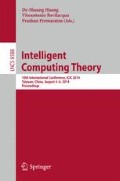Abstract
Conditional nonlinear optimal perturbation has been widely used in predictability and sensitivity studies of nonlinear numerical models. The main solution for CNOP is the adjoint-based method. However, many modern numerical models have no adjoint models which thus lead to a limitation of CNOP applications. To alleviate the limitation, we propose an ensemble projection method based on the orthogonal neighborhood preservation projection. To demonstrate the validity, we apply our method to CNOP of the Zebiak-Cane model and make a comparison with the adjoint-based method. Experimental results show that the proposed method can obtain similar results with the adjoint-based method.
Access this chapter
Tax calculation will be finalised at checkout
Purchases are for personal use only
Preview
Unable to display preview. Download preview PDF.
References
Lorenz, E.N.: A study of the predictability of a 28-variable atmosphere model. Tellus 17, 321–333 (1965)
Farrell, B.F.: Optimal excitation of baroclinic waves. J. Atmos. Sci. 46, 1193–1206 (1989)
Farrell, B.F., Moore, A.M.: An adjoint method for obtaining the most rapidly growing perturbation to oceanic flows. J. Phys. Oceanogr. 22, 338–349 (1992)
Mu, M., Duan, W.S.: A new approach to studying ENSO predictability: Conditional nonlinear optimal perturbation. Chin. Sci. Bull. 48, 1045–1047 (2003)
Duan, W.S., Mu, M., Wang, B.: Conditional nonlinear optimal perturbation as the optimal precursors for El Nino Southern oscillation events. J. Geophys. Res. 109, 1–12 (2004)
Mu, M., Jiang, Z.N.: A new approach to the generation of initial perturbations for ensemble prediction: Conditional nonlinear optimal perturbation. Chin. Sci. Bull. 53(13), 2062–2068 (2008)
Wang, B., Tan, X.W.: Conditional Nonlinear Optimal Perturbations: Adjoint-Free Calculation Method and Preliminary Test. American Meteorological Society 138, 1043–1049 (2010)
Chen, L., Duan, W.S.: A SVD-based Ensemble Projection Algorithm for Calculating conditional nonlinear optimal perturbation. Chinese Journal of Atmospheric Sciences (submmited, 2014) (in Chinese)
Wold, S., Esbensen, K., Geladi, P.: Principal component analysis. Chemometrics Intell. Lab. Syst. 2, 37–52 (1987)
Kokiopoulou, E., Saad, Y.: Orthogonal neighborhood preserving projections: A projection-based dimensionality reduction technique. IEEE Transactions on Pattern Analysis and Machine Intelligence 29(12), 2143–2156 (2007)
Zebiak, S.E., Cane, M.A.: A model El Nino-Southern Osillation. Mon. Wea. Rev. 115, 2262–2278 (1987)
Osborne, A.R., Pastorello, A.: Simultaneous occurence of low-dimensional chaos and colored random noise in nonlinear physical systems. Phys. Lett. A 181(2), 159–171 (1993)
Birgin, E.G., Martinez, J.M., Raydan, M.: Nonmonotone Spectral Projected Gradient Methods on Convex Sets. Society for Industrial and Applied Mathematics Journal on Optimization 10, 1196–1211 (2000)
Xu, H., Duan, W.S., Wang, J.C.: The Tangent Linear Model and Adjoint of a Coupled Ocean- Atmosphere Model and Its Application to the Predictability of ENSO. In: Procs: IEEE Int’l. Conf. on Geoscience and Remote Sensing Symposium, pp. 640–643 (2006)
Author information
Authors and Affiliations
Editor information
Editors and Affiliations
Rights and permissions
Copyright information
© 2014 Springer International Publishing Switzerland
About this paper
Cite this paper
Mu, B., Wen, S., Yuan, S., Li, H. (2014). Orthogonal Neighborhood Preservation Projection Based Method for Solving CNOP. In: Huang, DS., Bevilacqua, V., Premaratne, P. (eds) Intelligent Computing Theory. ICIC 2014. Lecture Notes in Computer Science, vol 8588. Springer, Cham. https://doi.org/10.1007/978-3-319-09333-8_14
Download citation
DOI: https://doi.org/10.1007/978-3-319-09333-8_14
Publisher Name: Springer, Cham
Print ISBN: 978-3-319-09332-1
Online ISBN: 978-3-319-09333-8
eBook Packages: Computer ScienceComputer Science (R0)

